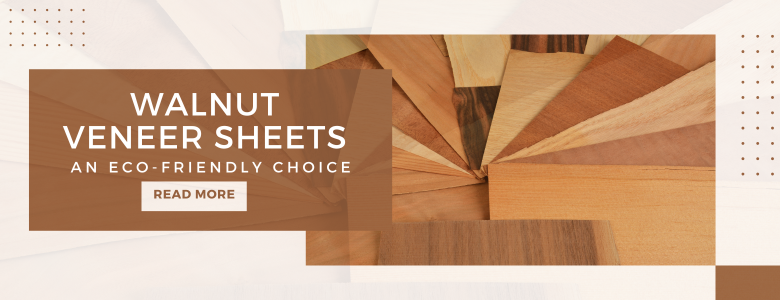Veneer Sheets, Wood Veneer
Sustainable Design: Why Walnut Veneer Sheets are an Eco-Friendly Choice
Walnut veneer sheets have become increasingly popular due to their sustainable, cost-effective, and visually appealing characteristics. Here’s a look at how walnut veneer sheets contribute to eco-friendly design choices in modern interiors and across various industries.
Environmental Advantages of Walnut Veneer Sheets
- Reduced Wood Usage
- Walnut veneer sheets require significantly less timber than solid wood, preserving natural forests.
- Veneers maximize the use of each log, offering more material with less waste.
PRO TIP: Choose sustainably sourced walnut veneer to further minimize environmental impact.
- Lower Carbon Footprint
- The production process of veneers generates fewer carbon emissions compared to solid wood.
- Less material shipping means a smaller carbon footprint due to the lighter weight of veneer sheets.
PRO TIP: Look for veneer sheets from suppliers who offset carbon emissions or support reforestation.
- Longer Lifespan Through Durability
- When maintained properly, walnut veneer sheets have a long lifespan, reducing the need for frequent replacements.
PRO TIP: Seal walnut veneer sheets with a low-VOC (volatile organic compounds) finish to protect and prolong their beauty.
Types of Design Applications Using Walnut Veneer Sheets in Modern Interiors
| Design Type | Usage of Walnut Veneer Sheets |
| Residential Interiors | Walls, cabinetry, furniture accents, doors, and paneling |
| Commercial Spaces | Reception desks, feature walls, partitions, and office furniture |
| Hospitality Design | Hotel lobbies, restaurant walls, bar counters, and decor |
| Retail | Display shelves, counters, wall panels, and signs |
| Corporate Offices | Executive desks, conference tables, and partitions |
PRO TIP: Incorporate walnut veneer sheets into focal areas, like accent walls or furniture, to add warmth and sophistication to the space.
Usage of Walnut Veneer Sheets Across Industries
- Furniture Manufacturing
- Common in tables, cabinets, chairs, and dressers due to versatility and natural wood appearance.
PRO TIP: Choose UV-resistant finishes for veneer furniture to prevent fading over time.
- Automotive Industry
- Applied in high-end car interiors on dashboards, door panels, and trim, adding a premium touch.
PRO TIP: Ensure proper bonding techniques for durability in temperature-variable environments.
- Interior Design and Architecture
- Frequently used in custom-designed spaces, luxury homes, and commercial buildings for aesthetic appeal.
PRO TIP: Use veneer sheets with distinct wood grains to create unique and visually striking designs.
- Boat and Yacht Manufacturing
- Due to its lightweight and attractive look, walnut veneer is used in cabinetry, walls, and flooring.
PRO TIP: Choose marine-grade veneers that are more resistant to moisture and wear.
Walnut Veneer Sheets vs. Solid Wood
| Feature | Walnut Veneer Sheets | Solid Wood |
| Material Usage | Uses thin layers, maximizing wood yield | Requires larger amounts |
| Cost | Generally more affordable | Higher cost for similar look |
| Environmental Impact | More sustainable, less wood waste | Higher impact, more timber used |
| Versatility in Design | Highly customizable for various applications | More limited, bulkier |
| Durability | Durable with proper maintenance | Naturally more durable |
| Weight | Lightweight, easier to handle and install | Heavier, may need reinforcement |
PRO TIP: For cost-effective, eco-friendly projects, walnut veneer sheets offer an attractive balance of aesthetic appeal and sustainability.
By choosing walnut veneer sheets, eco-conscious consumers and designers can enjoy the warmth and beauty of natural wood with minimal environmental impact.
